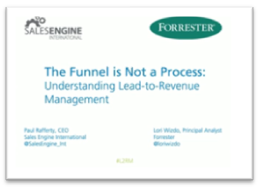Forrester Analyst Discusses New Approaches To Lead-To-Revenue Management
- Written by Fatima D. Lora
- Published in Revenue Strategies
 There are several challenges sales teams face throughout the various stages of the funnel process, including the need to improve efficiency and increase revenue growth.
There are several challenges sales teams face throughout the various stages of the funnel process, including the need to improve efficiency and increase revenue growth.
A recent webinar titled The Funnel Is Not A Process: Understanding Lead-To-Revenue Management, hosted by SalesEngine International, a B2B integrated marketing and sales acceleration company, highlighted trends in lead-to-revenue management.
With marketing automation, marketers have the capability to measure with more accuracy and step up to the challenge sales teams face, according to Lori Wizdo, Principal Analyst at Forrester Research. “By kicking lead generation up a notch, the marketing team works like demons; there’s a dramatic increase in traffic, leads, marketing-qualified leads (MQLs) and sales-qualified leads (SQLs). However, marketers continue to yield the same results: there’s minimal increase in marketing contribution to pipeline, limited contribution to revenue, and the relationship with sales isn’t getting any better. This leaves your CEO, CFO, VP of Sales and yourself wondering what went wrong.”
Based on research conducted by Forrester, on average 50% of B2B pipelines are marketing sourced. The number decreases to approximately 10% to 12% at larger companies.
“It’s no longer just about scaling the old model,” said Wizdo. “There’s a need for a new approach for Lead-to-Revenue Management (L2RM). Although the sales funnel is not dead, and is still very useful, it implies that marketing is just a numbers game, is passive, and most importantly it is blind to the buyer’s journey and doesn’t focus on the needs of each individual lead.”
Wizdo added: “For this reason, we cannot see the funnel as a process. The goal of the modern demand generation program is to move hundreds/thousands of leads through a process of sequential attribution until tens/thousands of deals emerge. It is critical to learn how to create a way to take a single lead through a process that is optimized to convert and help increase the buyer’s engagement through a managed process. Then, repeat that process hundreds/thousands of times.”
Forrester defines L2RM as a set of integrated goals, processes and metrics that shape marketing practices, from lead generation to revenue events, designed around the buyer.
The Concept Of Results Chain
Results chains enable marketers to focus the steps that create a designed outcome. For example, the actions, assumptions, contributions, outcomes and their impact are the building blocks of a results chain. In addition, a results chain approach helps to highlight the new competencies to develop.
“From the point of view of L2RM, results chains help marketers avoid analysis-paralysis, make cause and effect explicit, and helps marketers focus on what can be controlled,” said Wizdo.
Key takeaways for marketers from the L2RM webcast include:
- Automate for scale, consistency and ongoing improvement;
- Forget the funnel! Practice 1-on-1 L2RM; and
Take a results-based approach to process.

